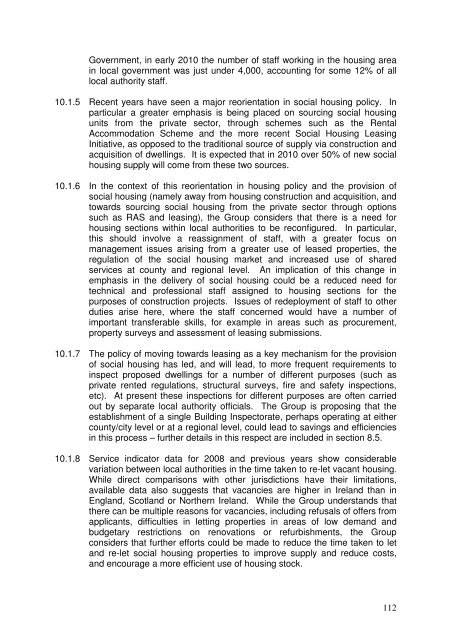Report of the Local Government Efficiency Review Group
Report of the Local Government Efficiency Review Group
Report of the Local Government Efficiency Review Group
Create successful ePaper yourself
Turn your PDF publications into a flip-book with our unique Google optimized e-Paper software.
<strong>Government</strong>, in early 2010 <strong>the</strong> number <strong>of</strong> staff working in <strong>the</strong> housing area<br />
in local government was just under 4,000, accounting for some 12% <strong>of</strong> all<br />
local authority staff.<br />
10.1.5 Recent years have seen a major reorientation in social housing policy. In<br />
particular a greater emphasis is being placed on sourcing social housing<br />
units from <strong>the</strong> private sector, through schemes such as <strong>the</strong> Rental<br />
Accommodation Scheme and <strong>the</strong> more recent Social Housing Leasing<br />
Initiative, as opposed to <strong>the</strong> traditional source <strong>of</strong> supply via construction and<br />
acquisition <strong>of</strong> dwellings. It is expected that in 2010 over 50% <strong>of</strong> new social<br />
housing supply will come from <strong>the</strong>se two sources.<br />
10.1.6 In <strong>the</strong> context <strong>of</strong> this reorientation in housing policy and <strong>the</strong> provision <strong>of</strong><br />
social housing (namely away from housing construction and acquisition, and<br />
towards sourcing social housing from <strong>the</strong> private sector through options<br />
such as RAS and leasing), <strong>the</strong> <strong>Group</strong> considers that <strong>the</strong>re is a need for<br />
housing sections within local authorities to be reconfigured. In particular,<br />
this should involve a reassignment <strong>of</strong> staff, with a greater focus on<br />
management issues arising from a greater use <strong>of</strong> leased properties, <strong>the</strong><br />
regulation <strong>of</strong> <strong>the</strong> social housing market and increased use <strong>of</strong> shared<br />
services at county and regional level. An implication <strong>of</strong> this change in<br />
emphasis in <strong>the</strong> delivery <strong>of</strong> social housing could be a reduced need for<br />
technical and pr<strong>of</strong>essional staff assigned to housing sections for <strong>the</strong><br />
purposes <strong>of</strong> construction projects. Issues <strong>of</strong> redeployment <strong>of</strong> staff to o<strong>the</strong>r<br />
duties arise here, where <strong>the</strong> staff concerned would have a number <strong>of</strong><br />
important transferable skills, for example in areas such as procurement,<br />
property surveys and assessment <strong>of</strong> leasing submissions.<br />
10.1.7 The policy <strong>of</strong> moving towards leasing as a key mechanism for <strong>the</strong> provision<br />
<strong>of</strong> social housing has led, and will lead, to more frequent requirements to<br />
inspect proposed dwellings for a number <strong>of</strong> different purposes (such as<br />
private rented regulations, structural surveys, fire and safety inspections,<br />
etc). At present <strong>the</strong>se inspections for different purposes are <strong>of</strong>ten carried<br />
out by separate local authority <strong>of</strong>ficials. The <strong>Group</strong> is proposing that <strong>the</strong><br />
establishment <strong>of</strong> a single Building Inspectorate, perhaps operating at ei<strong>the</strong>r<br />
county/city level or at a regional level, could lead to savings and efficiencies<br />
in this process – fur<strong>the</strong>r details in this respect are included in section 8.5.<br />
10.1.8 Service indicator data for 2008 and previous years show considerable<br />
variation between local authorities in <strong>the</strong> time taken to re-let vacant housing.<br />
While direct comparisons with o<strong>the</strong>r jurisdictions have <strong>the</strong>ir limitations,<br />
available data also suggests that vacancies are higher in Ireland than in<br />
England, Scotland or Nor<strong>the</strong>rn Ireland. While <strong>the</strong> <strong>Group</strong> understands that<br />
<strong>the</strong>re can be multiple reasons for vacancies, including refusals <strong>of</strong> <strong>of</strong>fers from<br />
applicants, difficulties in letting properties in areas <strong>of</strong> low demand and<br />
budgetary restrictions on renovations or refurbishments, <strong>the</strong> <strong>Group</strong><br />
considers that fur<strong>the</strong>r efforts could be made to reduce <strong>the</strong> time taken to let<br />
and re-let social housing properties to improve supply and reduce costs,<br />
and encourage a more efficient use <strong>of</strong> housing stock.<br />
112
















